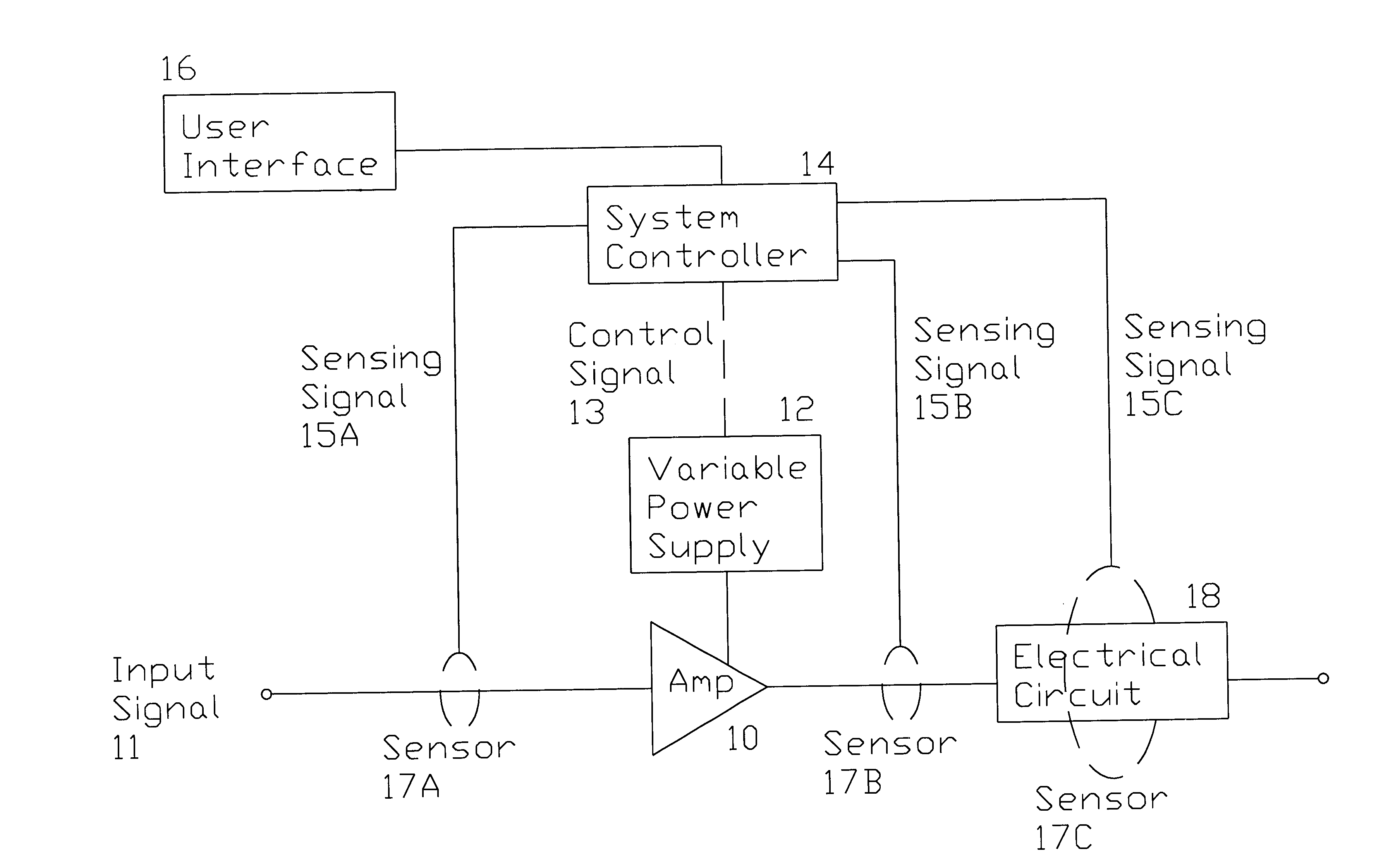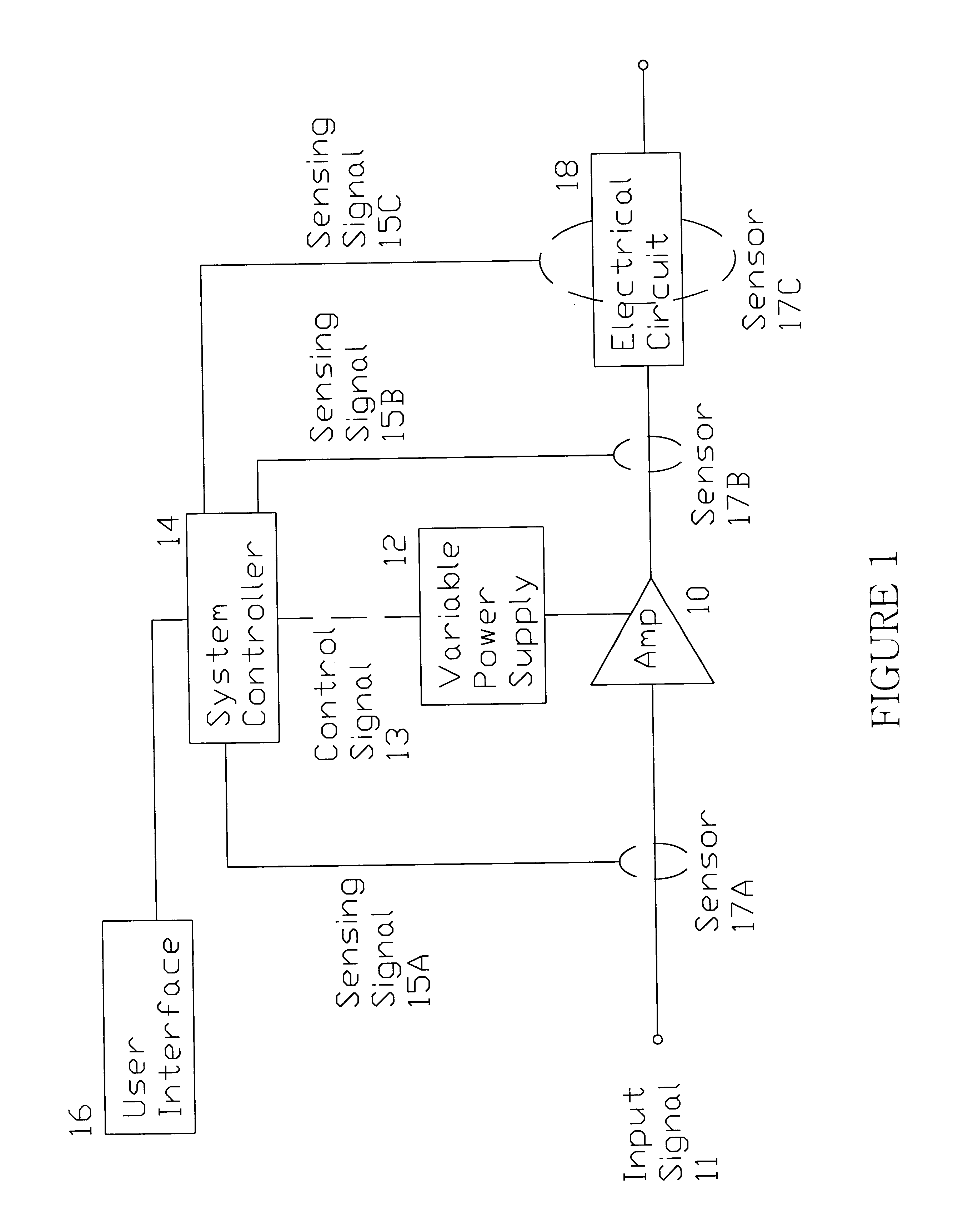System and method for minimizing dissipation in RF power amplifiers
a power amplifier and dissipation system technology, applied in the direction of push-pull amplifiers, phase splitters, gain control, etc., can solve the problems of higher maximum linear output, higher distortion limit, trade-off problems
- Summary
- Abstract
- Description
- Claims
- Application Information
AI Technical Summary
Problems solved by technology
Method used
Image
Examples
second embodiment
With reference now to FIG. 3, where like numerals represent like components in FIG. 1, which operate in a like manner, the invention is shown where the amplifiers 10-1 through 10-N are arranged in a cascaded series. A plurality of amplifiers is contemplated in the cascaded series shown, such as two amplifiers, three amplifiers, etc. In this embodiment, the variable power supply 12 is shown as supplying power to each of the cascaded amplifiers. The system controller 14, which preferentially comprises sensing means including a lookup table as described above, receives the sensing signals 15D and 15C. The sensing signal 15D may originate from one or more of the sensors 17N. Only one of the sensors 17N is labeled in FIG. 3 for clarity, but it is to be understood that the sensing signal 15D may originate from any of the sensors 17N shown immediately preceding or following one of the cascaded amplifiers 10-1 through 10-N. Sensing signal 15C may originate from the sensor 17C sensing the op...
third embodiment
With reference now to FIG. 4, where like numerals represent like components in FIGS. 1 and 3, which operate in a like manner, the invention is shown where the amplifiers 10-1 through 10-N are arranged in a cascaded series. A plurality of amplifiers is contemplated in the cascaded series shown, such as two amplifiers, three amplifiers, etc. In this embodiment, a one of variable power supply 12-1 through 12-N is associated with each one of the amplifiers 10-1 through 10-N, respectively, as shown. The system controller 14, which preferentially comprises sensing means including at least one lookup table as described above, receives the sensing signals 15D and 15C. As described above in the description of FIG. 3, the sensing signal 15D may originate from one or more of the sensors 17N. Only one of the sensors 17N is labeled in FIG. 4 for clarity, but it is to be understood that the sensing signal 15D may originate from any of the sensors 17N shown immediately preceding or following one o...
fourth embodiment
With reference now to FIG. 5, where like numerals represent like components in FIGS. 1, 3, and 4 which operate in a like manner, the invention is shown where the amplifiers 10-1 through 10-N are arranged in a parallel cascade. A plurality of amplifiers is contemplated in the parallel cascade shown, such as two amplifiers, three amplifiers, etc. In this embodiment, the variable power supply 12 is shown as supplying power to each of the parallel cascade of the amplifiers 10-1 through 10-N as shown. It is to be understood that the present invention also contemplates an individual variable power supply for each of the amplifiers 10-1 through 10-N, similar to the arrangement shown in the embodiment in FIG. 4. The embodiment with a plurality of variable power supply / amplifier pairs in a parallel cascade is not shown but may be inferred from this description.
The system controller 14, which preferentially comprises sensing means including at least one lookup table as described above, receiv...
PUM
 Login to View More
Login to View More Abstract
Description
Claims
Application Information
 Login to View More
Login to View More - R&D
- Intellectual Property
- Life Sciences
- Materials
- Tech Scout
- Unparalleled Data Quality
- Higher Quality Content
- 60% Fewer Hallucinations
Browse by: Latest US Patents, China's latest patents, Technical Efficacy Thesaurus, Application Domain, Technology Topic, Popular Technical Reports.
© 2025 PatSnap. All rights reserved.Legal|Privacy policy|Modern Slavery Act Transparency Statement|Sitemap|About US| Contact US: help@patsnap.com



